Cadmus
In Greek mythology, Cadmus (/ˈkædməs/; Greek: Κάδμος Kadmos), was the founder and first king of Thebes.[1] Cadmus was the first Greek hero and, alongside Perseus and Bellerophon, the greatest hero and slayer of monsters before the days of Heracles.[2] Commonly stated to be a Phoenician prince, son of king Agenor and queen Telephassa of Tyre and the brother of Phoenix, Cilix and Europa, he was originally sent by his royal parents to seek out and escort his sister Europa back to Tyre after she was abducted from the shores of Phoenicia by Zeus.[3] In early accounts, Cadmus and Europa were instead the children of Phoenix.[4] Cadmus founded the Greek city of Thebes, the acropolis of which was originally named Cadmeia in his honour.
| Cadmus | |
|---|---|
 | |
| Abode | Thebes |
| Personal information | |
| Born | Phoenicia, Tyre, Sidon or Thebes in Egypt |
| Parents | Agenor and Telephassa or Phoenix and Perimede |
| Siblings | Europa, Cilix, Phoenix |
| Consort | Harmonia |
| Children | Polydorus, Autonoë, Ino, Agave, Semele |
| Greek mythology |
|---|
 |
| Deities |
| Heroes and heroism |
| Related |
|
|
|
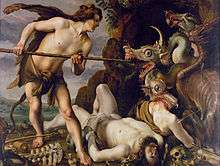
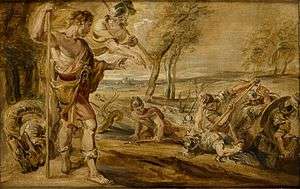
"His native country is commonly stated to have been Phoenicia, as in Apollodorus; but he is sometimes called a Tyrian [from Tyre], and sometimes a Sidonian [from Sidon]. Others regarded Cadmus as a native of Thebes in Egypt, and his parentage is modified accordingly; for he is also called a son of Antiope, the daughter of Belus, or of Argiope, the daughter of Neilus."[5]
Cadmus was credited by the ancient Greeks (such as Herodotus[6] c. 484 – c. 425 BC, one of the first Greek historians, but one who also wove standard myths and legends through his work) with introducing the original Phoenician alphabet to the Greeks, who adapted it to form their Greek alphabet. Herodotus estimates that Cadmus lived sixteen hundred years before his time, which would be around 2000 BC.[7] Herodotus had seen and described the Cadmean writing in the temple of Apollo at Thebes engraved on certain tripods. He estimated those tripods to date back to the time of Laius the great-grandson of Cadmus.[8] On one of the tripods there was this inscription in Cadmean writing, which, as he attested, resembled Ionian letters: Ἀμφιτρύων μ᾽ ἀνέθηκ᾽ ἐνάρων ἀπὸ Τηλεβοάων ("Amphitryon dedicated me [don't forget] the spoils of [the battle of] Teleboae.").
Although Greeks like Herodotus dated Cadmus's role in the founding myth of Thebes to well before the Trojan War (or, in modern terms, during the Aegean Bronze Age), this chronology conflicts with most of what is now known or thought to be known about the origins and spread of both the Phoenician and Greek alphabets. The earliest Greek inscriptions match Phoenician letter forms from the late 9th or 8th centuries BC—in any case, the Phoenician alphabet properly speaking was not developed until around 1050 BC (or after the Bronze Age collapse). The Homeric picture of the Mycenaean age betrays extremely little awareness of writing, possibly reflecting the loss during the Dark Age of the earlier Linear B script. Indeed, the only Homeric reference to writing[9] was in the phrase "γράμματα λυγρά", grámmata lygrá, literally "baneful drawings", when referring to the Bellerophontic letter. Linear B tablets have been found in abundance at Thebes, which might lead one to speculate that the legend of Cadmus as bringer of the alphabet could reflect earlier traditions about the origins of Linear B writing in Greece (as Frederick Ahl speculated in 1967[10]). But such a suggestion, however attractive, is by no means a certain conclusion in light of currently available evidence. The connection between the name of Cadmus and the historical origins of either the Linear B script or the later Phoenician alphabet, if any, remains elusive. However, in modern-day Lebanon, Cadmus is still revered and celebrated as the "carrier of the letter" to the world.
According to Greek myth, Cadmus's descendants ruled at Thebes on and off for several generations, including the time of the Trojan War.
Etymology
The etymology of Cadmus' name remains uncertain.[11] Possible connected words include the Semitic triliteral root qdm (Ugaritic: 𐎖𐎄𐎎)[12] signifies "east", in Arabic, words derived from the root "qdm" include the verb “qdm” meaning “to come” as well as words meaning "primeval" and "forth" as well as "foot", (in Hebrew, qedem means "east","front" and "ancient"(primeval); the verb qadam (Syriac: ܩܕܡ) means "to be in front"),[13][14] and the Greek kekasmai (<*kekadmai) "to shine".[note 1] Therefore, the complete meaning of the name might be: "He who excels" or "from the east".[16]
Wanderings
Samothrace
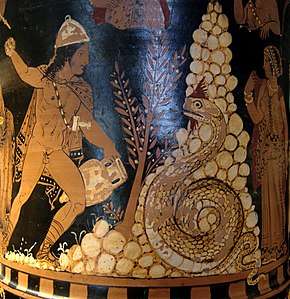
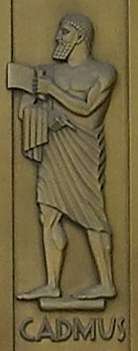
After his sister Europa had been carried off by Zeus from the shores of Phoenicia, Cadmus was sent out by his father to find her, and enjoined not to return without her. Unsuccessful in his search—or unwilling to go against Zeus—he came to Samothrace, the island sacred to the "Great Gods"[17] or the Kabeiroi, whose mysteries would be celebrated also at Thebes.
Cadmus did not journey alone to Samothrace; he appeared with his mother Telephassa[18] in the company of his nephew (or brother) Thasus, son of Cilix, who gave his name to the island of Thasos nearby. An identically composed trio had other names at Samothrace, according to Diodorus Siculus:[19] Electra and her two sons, Dardanos and Eetion or Iasion. There was a fourth figure, Electra's daughter, Harmonia,[20] whom Cadmus took away as a bride, as Zeus had abducted Europa.[21]
The wedding was the first celebrated on Earth to which the gods brought gifts, according to Diodorus[22] and dined with Cadmus and his bride.[23]
Founder of Thebes
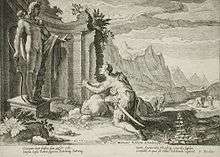
Cadmus came in the course of his wanderings to Delphi, where he consulted the oracle. He was ordered to give up his quest and follow a special cow, with a half moon on her flank, which would meet him, and to build a town on the spot where she should lie down exhausted.[24]
The cow was given to Cadmus by Pelagon, King of Phocis, and it guided him to Boeotia, where he founded the city of Thebes.
Intending to sacrifice the cow to Athena, Cadmus sent some of his companions, Deioleon and Seriphus to the nearby Ismenian spring for water.[25][26] They were slain by the spring's guardian water-dragon (compare the Lernaean Hydra), which was in turn destroyed by Cadmus, the duty of a culture hero of the new order.
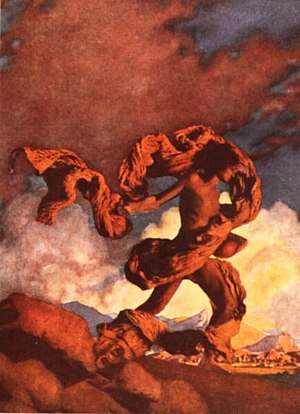
He was then instructed by Athena to sow the dragon's teeth in the ground, from which there sprang a race of fierce armed men, called the Spartoi ("sown"). By throwing a stone among them, Cadmus caused them to fall upon one another until only five survived, who assisted him to build the Cadmeia or citadel of Thebes, and became the founders of the noblest families of that city.
The dragon had been sacred to Ares, so the god made Cadmus do penance for eight years by serving him. According to Theban tellings, it was at the expiration of this period that the gods gave him Harmonia ("harmony", literally "putting or assembling together", "good assembly", or "good composition) as wife.[27] At Thebes, Cadmus and Harmonia began a dynasty with a son Polydorus, and four daughters, Agave, Autonoë, Ino and Semele.
At the wedding, whether celebrated at Samothrace or at Thebes, all the gods were present; Harmonia received as bridal gifts a peplos worked by Athena and a necklace made by Hephaestus. This necklace, commonly referred to as the Necklace of Harmonia, brought misfortune to all who possessed it. Notwithstanding the divinely ordained nature of his marriage and his kingdom, Cadmus lived to regret both: his family was overtaken by grievous misfortunes, and his city by civil unrest. Cadmus finally abdicated in favor of his grandson Pentheus, and went with Harmonia to Illyria, to fight on the side[28] of the Enchelii.[29] Later, as king, he founded the city of Lychnidos and Bouthoe.[30]
Nevertheless, Cadmus was deeply troubled by the ill-fortune which clung to him as a result of his having killed the sacred dragon, and one day he remarked that if the gods were so enamoured of the life of a serpent, he might as well wish that life for himself. Immediately he began to grow scales and change in form. Harmonia, seeing the transformation, thereupon begged the gods to share her husband's fate, which they granted (Hyginus).
In another telling of the story, the bodies of Cadmus and his wife were changed after their deaths; the serpents watched their tomb while their souls were translated to the fields. In Euripides' The Bacchae, Cadmus is given a prophecy by Dionysus whereby both he and his wife will be turned into snakes for a period before eventually being brought to live among the blest.
Samothracian connection
In Phoenician, as well as Hebrew, the Semitic root qdm signifies "the east", the Levantine origin of "Kdm" himself, according to the Greek mythographers; the equation of Kadmos with the Semitic qdm was traced to a publication of 1646 by R. B. Edwards.[31] The name Kadmos has been thoroughly Hellenised. The fact that Hermes was worshipped in Samothrace under the name of Cadmus or Cadmilus seems to show that the Theban Cadmus was interpreted as an ancestral Theban hero corresponding to the Samothracian. Another Samothracian connection for Cadmus is offered via his wife Harmonia, who is said by Diodorus Siculus to be daughter of Zeus and Electra and of Samothracian birth.[32]
The "Wedding of Cadmus and Harmonia" is considered as a conceptual symbolic coupling of Eastern (Phoenician) learning with Western (Greek) love of beauty. He died tragicallly by getting killed by Ares the God of war.
Genealogy
Cadmus was of ultimately divine ancestry, the grandson of the sea god Poseidon and Libya on his father's side, and of Nilus (the River Nile) on his mother's side; overall he was considered a member of the fifth generation of beings following the (mythological) creation of the world:
|
Offspring
With Harmonia, he was the father of Semele, Polydorus, Autonoe, Agave and Ino. Their youngest son was Illyrius.[33] According to Greek mythology, Cadmus is the ancestor of Illyrians and Theban royalty.[34]
Hittite records controversy
It has been argued by various scholars, that in a letter from the King of Ahhiyawa to the Hittite King, written in the Hittite language in c. 1250 BC, a specific Cadmus was mentioned as a forefather of the Ahhijawa people. The latter term most probably referred to the Mycenaean world (Achaeans), or at least to a part of it.[35][36] Nevertheless, this reading about a supposed Cadmus as historical person is rejected by most scholars.[37]
Trivia
The Syrian city of Al-Qadmus is named after Cadmus.[38]
Citations
- Alden, John B. (1883) The Greek Anthology, pp. 160–162.
- Kerenyi, Karl, 1959. The Heroes of the Greeks (London: Thames and Hudson) p. 75.
- A modern application of genealogy would make him the paternal grandfather of Dionysus, through his daughter by Harmonia, Semele. Plutarch once admitted that he would rather be assisted by Lamprias, his own grandfather, than by Dionysus' grandfather, i.e. Cadmus. (Symposiacs, Book IX, question II Archived 13 October 2008 at the Wayback Machine)
- Scholia on Homer, Iliad B, 494, p. 80, 43 ed. Bekk. as cited in Hellanicus' Boeotica
- Smith, William, Sir, ed. (1870). Dictionary of Greek and Roman Biography and Mythology. Boston: Little Brown and Company. p. 524. ark:/13960/t9s17xn41.
- Herodotus' Histories, Book V, 58.
- Herodotus. Histories, Book II, 2.145.4.
- Herodotus. Histories, Book V.59.1
- There are several examples of written letters, such as in Nestor's narrative concerning Bellerophon and the "Bellerophontic letter", another description of a letter presumably sent to Palamedes from Priam but in fact written by Odysseus (Hyginus. Fabulae, 105), as well as the letters described by Plutarch in Parallel Lives, Theseus, which were presented to Ariadne, presumably sent from Theseus. Plutarch goes on to describe how Theseus erected a pillar on the Isthmus of Corinth, which bears an inscription of two lines.
- F. M. Ahl. "Cadmus and the Palm-Leaf Tablets". American Journal of Philology 88.2, Apr. 1967, pp. 188–194.
- LSJ s.v. Κάδμος.
- Gregorio del Olmo Lete; Joaquín Sanmartín (2003). A Dictionary of the Ugaritic Language in the Alphabetic Tradition - Part One (PDF). Brill. p. 694. ISBN 90-04-12891 3. Archived from the original (PDF) on 30 December 2017. Retrieved 12 February 2018.
- Compare: Graves, Robert (1955). "58: Europe and Cadmus". The Greek Myths. 1. London: Penguin (published 1990). ISBN 9781101554982. Retrieved 11 November 2016.
[...] a small tribe, speaking a Semitic language, seems to have moved up from the Syrian plains to Cadmeia in Caria – Cadmus is a Semitic word meaning 'eastern' [...].
- Ruprecht, Louis A., Jr. (2008). God Gardened East: A Gardener's Meditation on the Dynamics of Genesis. Wipf and Stock Publishers. p. 31. ISBN 9781556354342.
- R. S. P. Beekes, Etymological Dictionary of Greek, Brill, 2009, p. 614.
- "Cadmus". Baby Names. SheKnows. Retrieved 14 January 2017.
The name Cadmus is a Greek baby name. In Greek the meaning of the name Cadmus is: He who excels; from the east.
- The Megaloi theoi of the Mysteries of Samothrace.
- Or known by another lunar name, Argiope, "she of the white face" (Kerenyi 1959:27).
- Diodorus Siculus, 5.48; Clement of Alexandria, to wit Proreptikos 2.13.3.
- Harmonia at Thebes was accounted the daughter of Ares and Aphrodite; all these figures appeared in sculptures on the pediment of the Hellenistic main temple in the Sanctuary of the Great Gods at Samothrace, the Hieron; the ancient sources on this family grouping were assembled by N. Lewis, Samothrace. I: The Ancient Literary Sources (New York) 1958:24-36.
- Kerenyi (1959) notes that Cadmus in some sense found another Europa at Samothrace, according to an obscure scholium on Euripides' Rhesus 29.
- Diodorus, 5.49.1; when the gods attended the later wedding of Peleus and Thetis, the harmony was shattered by the Apple of Discord.
- The full range of references in Antiquity to this wedding is presented by Matia Rocchi, Kadmos e Harmonia: un matrimonio problemmatico (Rome: Bretschneider) 1989.
- http://mythology.stackexchange.com/a/2495/2892/
- John Tzetzes. Chiliades, 10.32 line 4
- Atsma, Aaron J. "Drakon Ismenia". Theoi Greek Mythology. Retrieved 5 September 2014.
- Scholia on Homer, Iliad B, 494, p. 80, 43 ed. Bekk. as cited in Hellanicus' Boeotica
- Apollodorus. Library and Epitome, 3.5.4.
- Pierre Grimal, Pierre, Maxwell-Hyslop, A. R. The Dictionary of Classical Mythology. Blackwell, 1996, ISBN 0-631-20102-5, p. 83.
- Wilkes, J. J. The Illyrians. Blackwell Publishing, 1992, ISBN 0-631-19807-5, p. 99.
- Edwards, Kadmos the Phoenician: A Study in Greek Legends and the Mycenaean Age (Amsterdam 1979), noted by Walter Burkert, The Orientalizing Revolution: Near Eastern Influence on Greek Culture in the Early Bronze Age (Harvard University Press) 1992:2, and note), who remarks that the complementary connection of Europa with rb, "West" was an ancient one, made by Hesychius.
- Diodorus Siculus 5.48.2
- Pierre Grimal, Pierre, Maxwell-Hyslop, A. R. The Dictionary of Classical Mythology. Blackwell, 1996, ISBN 0-631-20102-5, pp. 83, 230.
- Parsons, P.J. (2011). Culture In Pieces: Essays on Ancient Texts in Honour of Peter Parsons. p. 204.
- Windle, Joachim Latacz. Transl. from the German by Kevin; Ireland, Rosh (2004). Troy and Homer towards a solution of an old mystery. Oxford: Oxford Univ. Press. p. 244. ISBN 9780199263080.
- Rava, R D'Amato & A Salimbeti ; illustrated by Giuseppe (22 March 2011). Bronze age Greek warrior 1600-1100 BC. Oxford, UK: Osprey Pub Co. p. 58. ISBN 9781849081955.
- Strauss, Barry (2007). The Trojan War : a new history (1st trade paperback ed.). New York: Simon & Schuster. p. 19. ISBN 9780743264426.
- ""أهلا بكم في مدينة الفينيقين القديمة "القدموس". esyria (in Arabic). 20 April 2009.
References
Classical sources
- Hyginus. Fabulae, 178.
- Pseudo-Apollodorus. Bibliotheke, III, i, 1-v, 4;
- Ovid. Metamorphoses, III, 1-137; IV, 563-603.
- Homer. The Odyssey, 5.333.
Secondary material
- Theoi Project
- Kerenyi, Karl. The Heroes of the Greeks, 1959.
- Vian, F. Les origines de Thébes: Cadmos et les Spartes. Paris, 1963.
- R. B. Edwards. Kadmos, the Phoenician: A Study in Greek Legends and the Mycenaean Age. Amsterdam, 1979.
- T. Gantz. Early Greek Myth., Volume 2, 467–73.
- Matia Rocchi. Kadmos e Harmonia: un matrimonio problemmatico. Rome, Bretschneider, 1989.
- Svetlana Janakieva, "Lе Mythe de Cadmos et l'aire ethnolinguistique paleobalkanique," Thracia, 11, 1995 (= Studia in honorem Alexandri Fol. Sofia, 1995).

Further reading
- Calasso, Roberto (1993). The Marriage of Cadmus and Harmony. New York: Knopf. ISBN 0-394-58154-7.
External links
| Wikisource has the text of the 1911 Encyclopædia Britannica article Cadmus. |
| Wikimedia Commons has media related to Cadmus. |
- Images of Cadmus in the Warburg Institute Iconographic Database
| Regnal titles | ||
|---|---|---|
| New creation | Mythical King of Thebes | Succeeded by Pentheus |